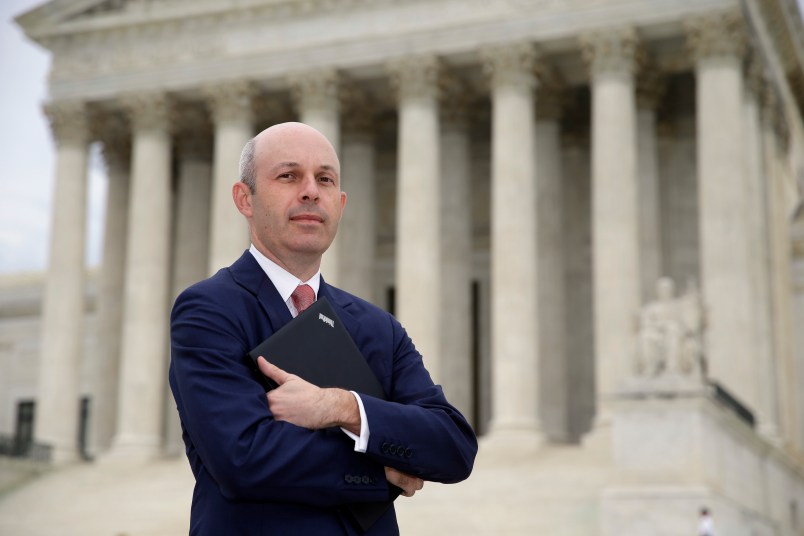There’s been a bubbling hum of controversy surrounding the Senate Daily Press Gallery’s decision to deny credentials to SCOTUSBlog. And as it happens, the issues involved here are ones I know fairly well since I’m the owner of a new media company and had to navigate the DC credentialing for something like 15 years, first for The American Prospect and later for TPM. And in the case of TPM this was when the whole concept of such an organization was far more novel and hard to make sense of. We’ve been successfully credentialed on Capitol Hill for years now. But I have a fair amount of hard experience and built up on knowledge on this issue. So I thought I’d share my thoughts.
First, I think the Daily Press Gallery’s decision is wrong and frankly stupid. But before getting into why, a few points.
First, the issue of editorial independence and especially the issue of lobbying is a real and legitimate one. Congressional press passes give the holders the ability to roam the place not quite at will but with far more freedom and access than the general public. It’s the kind of access lobbying firms or industry groups would kill for. So there’s good reason to scrutinize organizations to make sure they are not fronts for organizations with business before Congress.
Perhaps today, everyone is a citizen journalist. But for the reasons I note, the Galleries have very good reason to extend membership to people who are journalists full time and meet some set of criteria rather than literally giving them out to anyone who shows up and calls themselves a journalist.
When I first tried to get credentials for The American Prospect in the late 90s I was initially put off because the Prospect is a non-profit (in more ways than one, rimshot!) and thus we didn’t seem like a real news organization to them. Who were our funders? Were we stalking horses for them and so forth.
As with most of these things, sort of reasonable, except that being a for-profit doesn’t make you a more real journalism organization. And the rules of all the galleries tend to be strictly enforced except when they’re not.
In the early days of TPM, I did a few fundraisers to build new parts of the site. So again, who were these mystery funders and what was their agenda? Well, they were a couple thousand people across the country making contributions ranging from $10 to $20 and occasionally $100. To think this somehow made TPM not editorially independent in a way that was at all relevant for credentialing purposes was ridiculous.
Now, let me say here that I was able to develop a good relationship with the Gallery TPM got credentialed with. And generally speaking they were very fair and sometimes even more than fair. But I got a sense of the issues that credentialing turned on. And critically, the professional staff of the galleries isn’t in charge. There are boards of fellow journalists who make the decision.
Now, in the case of SCOTUSBlog, when I first heard about the controversy, I thought proprietor Tom Goldstein worked for one of the big DC law firms, almost all of which have either formal or de facto lobbying divisions. I’m still not sure that’s a good enough reason to deny them. But it would come up against the rule that’s at the core (and rightly so) of the credentialing process – are you a journalist or are you a covert lobbyist? But that’s not even the case. It’s a boutique firm doing Supreme Court appellate work.
Goldstein used to work for Akin Gump (which very much has a lobbying practice) and Akin Gump sponsored the site. But he’s since decamped from AG and practices at a small firm dedicated exclusively to appellate work and also running SCOTUSBlog.
Finally, you may be asking, why are they applying for credentials to cover Congress? They don’t even cover Congress. Good question! This goes to yet another of the very convoluted ways credentialing works in DC. The Supreme Court doesn’t have a credentialing process. They issue a credential if you have one from Congress or, I believe, from the White House – a number of institutions in DC do this. So perverse as it may be, SCOTUSBlog has no choice but to apply to the Senate Gallery, even though other than perhaps covering confirmations it doesn’t cover the Senate or Congress at all.
One pretty obvious solution is for the Court just to issue a credential. But that doesn’t seem possible. So the Senate gallery it is.
With that all out of the way, the committee in charge has resorted to finding increasingly creative ways to block SCOTUSBlog from membership. The only realistic way to explain the decision-making process would be, given this set of rules that we have, how do we interpret them in such a way as to block SCOTUSBlog’s application for credentials.
The explanation hangs on two parts. First, since SCOTUSBlog is owned by Goldstein and his firm who regularly argue cases before the Supreme Court, they can’t get credentials because this constitutes a form of lobbying.
At the same time, Mr. Goldstein advocates before the Supreme Court, which is a form of lobbying the federal government. Thus, SCOTUSblog fails the test of editorial independence from any institution that lobbies the federal government because it is instead editorially intertwined with a law partner and a firm that lobbies the federal government.
This is simply a ridiculous bit of reasoning. Arguing a case before the Supreme Court is simply not lobbying. Period. That’s silly. There are other potential issues about whether Goldstein might write about a case he’s a party to. But they seem to have guidelines and firewalls in place to guard against this sort of thing.
Again, this is a ridiculous piece of reasoning. And the only way to explain it is that the committee was looking for a way to map its rules on to a way to reject the application.
The second argument is more diffuse and centers on the ownership/business relationship of Goldstein’s firm and various rules that state the publication can’t be owned or controlled by an entity whose principle activity isn’t journalism. Now plenty of snarking possible here about the various credentialed publications owned by diversified manufacturing firms, telecommunication companies and hedge funds. But let’s take the rule on its own terms and see that at least in theory they’re not talking about simple ownership but editorial control. Again, it’s stretching the bounds of credulity here not to see that this really would put many if not most of the publications in jeopardy. But here Goldstein says and the record seems to back him up that he’s put in place various firewalls and guidelines to wall SCOTUSBlog off from the commercial aspects of the firm.
The committee simply says they’re not enough and further goes on to these fairly circuitous arguments that amount to saying that it would only be enough if Goldstein recused himself from all editorial involvement in Goldstein’s blog. And then beyond that there’s this. “Mr. Goldstein also uses SCOTUSblog as a platform for publicity material about himself, making the blog part of his personal brand.”
Again, when you read this line you realize your reading an argument based on an almost comical level of grasping. There is no rule about a publication not being part of person’s personal brand. Indeed, the whole concept of a personal brand is quite new and was never even conceived of when these rules were initiated.
There is an irreducible issue here which is real. Goldstein’s ownership and writing for SCOTUSBlog inevitably helps gain him clients because it’s made him a star in the news and legal community. No amount of firewalls other than him ceasing to practice law will get around that.
I’d never spoken to Goldstein about this issue (in fact, I don’t think I’d ever spoken to him before about anything) until this morning when I called him up to confirm my understanding about the nature of his law firm. He’s quite clear that when SCOTUSBlog started it was more promotional in nature. But clearly, as anyone involved in the news business or the appellate portion of the legal profession knows, it’s evolved way, way beyond that since then. And Goldstein says he’s put various guidelines and rules into effect to segment off the editorial integrity of the site from his own legal practice.
At the end of the day, all of it comes down to this. SCOTUSBlog is the preeminent source of real-time and journalistic reporting on the Supreme Court in the country. I say this with full knowledge that there are many extremely talented Supreme Court and legal affairs reporters working for various newspapers and news outlets. And it’s no disrespect at all to them. (I have no idea who the best individual Supreme Court reporter is.) The simple fact is that whenever a big case comes down, basically everyone goes to SCOTUSBlog to get the first read on what happened. This is quite simply a fact.
So you have this perverse situation in which what is arguably and close to objectively the top source of reporting and commentary on the Supreme Court being basically the only ones who aren’t credentialed to cover it. That’s the problem with this decision. From what I can see, the rules don’t at all prevent the committee from issuing SCOTUSBLog a credential. If the rules do, then the rules are outmoded and should change.
As Andrew Jackson once reportedly said when he was a judge, “If that is the law then the law is an ass.” (Others cite other origins.) If the rules really require this outcome, then you’ve got bad rules.








